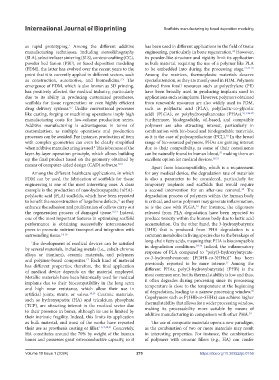Page 283 - IJB-10-1
P. 283
International Journal of Bioprinting Scaffolds manufacturing by fused deposition modeling
as rapid prototyping. Among the different additive has been used in different applications in the field of tissue
1
manufacturing techniques, including stereolithography engineering, particularly in bone regeneration. However,
22
(SLA), selective laser sintering (SLS), contour crafting (CC), its powder-like structure and rigidity limit its application
powder bed fusion (PBF), or fused deposition modeling as bulk material, requiring the use of a polymer like PLA
(FDM), the latter has evolved over the recent years to the to be embedded into during the processing stage. 21,23-25
point that it is currently applied in different sectors, such Among the matrices, thermoplastic materials deserve
as construction, automotive, and biomedicine. The special attention, as they are mostly used in FDM. Polymers
2-5
emergence of FDM, which is also known as 3D printing, derived from fossil resources such as polyethylene (PE)
has positively affected the medical industry, particularly have been broadly used in producing implants used in
due to its ability in producing customized prostheses, applications such as implants. However, polymers obtained
scaffolds for tissue regeneration or even highly efficient from renewable resources are also widely used in FDM,
drug delivery systems. Unlike conventional processes such as polylactic acid (PLA), poly(lactic-co-glycolic
6,7
like casting, forging or machining operations imply high acid) (PLGA), or polyhydroxyalkanoates (PHAs). 5,11,26-29
manufacturing costs for low-volume production series. Furthermore, biodegradable, oil-based, and compatible
Additive manufacturing is advantageous in terms of polymers are also attracting interest, particularly in
customization, as multiple operations and production combination with bio-based and biodegradable materials,
processes can be avoided. For instance, production of item as it is the case of polycaprolactone (PCL). In the broad
30
with complex geometries can even be clearly simplified range of bio-sourced polymers, PHAs are gaining interest
when additive manufacturing is used. This is because of the due to their compatibility, as some of their constituents
8
layer-by-layer operation principle, which allows building can be naturally found in human blood, making them an
27
up the final product based on the geometry obtained by excellent option for medical devices. 29,31
means of computer-aided design (CAD) software. 9,10 Apart from biocompatibility, which is a requirement
Among the different healthcare applications, in which for any medical device, the degradation rate of materials
FDM can be used, the fabrication of scaffolds for tissue is also a parameter to be considered, particularly for
engineering is one of the most interesting ones. A clear temporary implants and scaffolds that would require
example is the production of nanohydroxyapatite (nHA)- a second intervention for an after-use removal. The
32
polylactic acid (PLA) scaffolds, which have been reported degradation process of polymers within the human body
to benefit the reconstruction of large bone defects, as they is critical, and some polymers may generate inflammation,
11
enhance the adhesion and proliferation of cells to carry out as is the case with PLGA. For instance, the oligomers
33
the regeneration process of damaged tissue. 12,13 Indeed, released from PLA degradation have been reported to
one of the most important features in optimizing scaffold produce toxicity within the human body due to lactic acid
performance is obtaining successfully interconnected accumulation. On the other hand, the 3-hydroxybutyrate
pores to promote nutrient transport and integration with (3HB) that is produced from PHA degradation is a
surrounding tissue. 14-16 common metabolite in living species due to the breakage of
long-chain fatty acids, meaning that PHA is biocompatible
The development of medical devices can be satisfied 34-36
by several materials, including metals (i.e., cobalt-chrome in degradation conditions. Indeed, the inflammatory
response of PLA compared to “poly(3-hydroxybutyrate-
alloys or titanium), ceramic materials, and polymers co-3-hydroxyhexanoate [P(3HB-co-3HHx)]” has been
and polymer-based composites. Each kind of material previously reported to be more intense. Among the
17
37
has different properties; therefore, the final application different PHAs, poly(3-hydroxybutyrate) (PHB) is the
of medical device depends on the material employed. most common one, but its thermal stability is low and thus,
Metallic materials have been historically used for medical it often degrades during processing since its processing
implants due to their biocompatibility in the long term temperature is close to the temperature at the beginning
and high wear resistance, which allow their use in of degradation, leading to a narrow processing window.
38
artificial joints, stents, or valves. 18,19 Ceramic materials, Copolymers such as P(3HB-co-3HHx) can achieve higher
such as hydroxyapatite (HA) and tricalcium phosphate thermal stability that allows for a wider processing window,
(TCP), are attracting interest in the medical sector due making its processability more suitable by means of
to their presence in bones, although its use is limited by additive manufacturing in comparison with other PHA. 39
their intrinsic fragility. Indeed, this limits its application
as bulk material, and most of the works have reported The use of composite materials opens a new paradigm,
their use as prosthesis coating or filler. 11,13,20,21 Concretely, as the combination of two or more materials may result
HA constitutes around the 70% by weight of the human in interesting properties. For instance, the combination
bones and possesses great osteoconductive capacity, so it of polymers with ceramic fillers (e.g., HA) can confer
Volume 10 Issue 1 (2024) 275 https://doi.org/10.36922/ijb.0156

